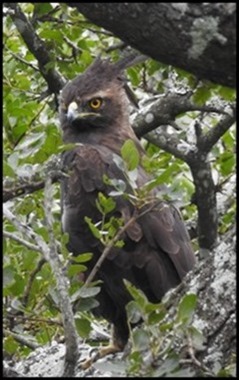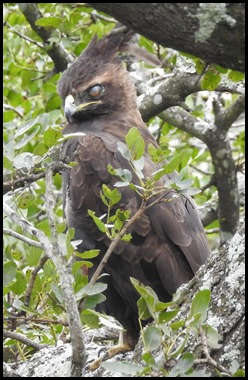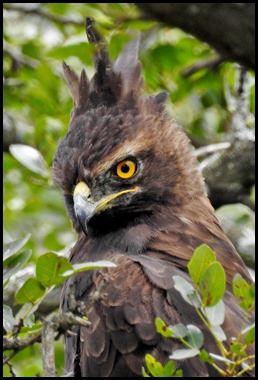Day One Hluhluwe Park - Part One

|
Day One Hluhluwe Park – Part One
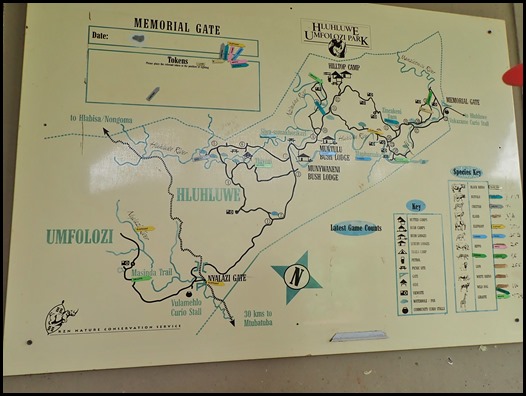 We left Beez
Neez and Slow Flight at eight heavily laden with food and
excitement. By ten we were paying our entry tickets at the Memorial Gate, buying
a guide pamphlet and taking pictures of recent sightings.
 In we drove, as far as the eye could see in all directions was a
vast area of green dotted with trees with the
occasional hill. We were going to have to work for our sightings. Trevor, map in
hand was on point, Kimi in the back on binoculars, me on long lens and Bear on
casual lookout with orders to “stop” on seeing anything.
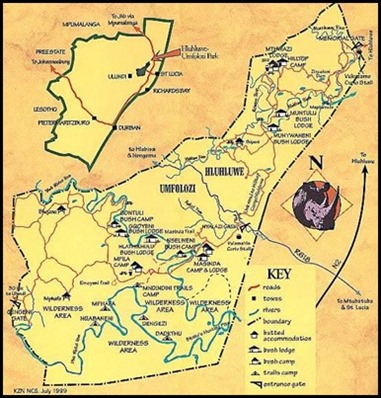  The iMfolozi (or Umfolozi) Park was established in 1895 and
covers some 24,000 hectares is set aside for wilderness. Hluhluwe (believe it or not pronounced Shoosh-louie) was
established in 1897 and straddles mountainous terrain, several lookouts and The
Hilltop Lodge where we will eat lunch. Today we will concentrate on Hluhluwe and
the day after tomorrow on iMfolozi. Love it when we have a
plan......especially if it comes together. I
feel it in my water. OK
then.
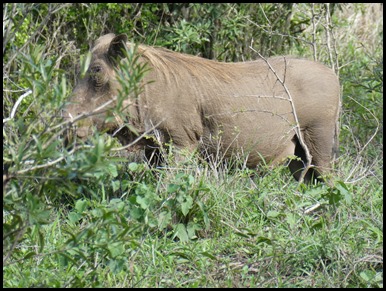 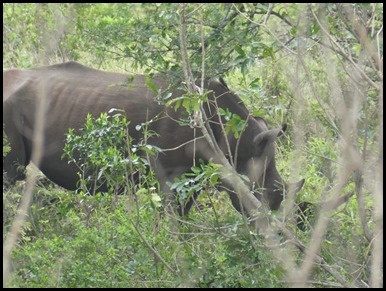 In what seemed like seconds Trevor glimpsed a
wild boar, then
bade Bear turn left off the main park road, the track was narrower and
anticipation was at the ready. Bear spotted our first
rhino some distance away and well hidden. Well done boys.
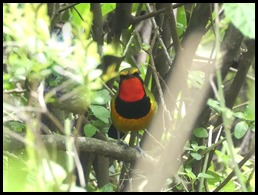 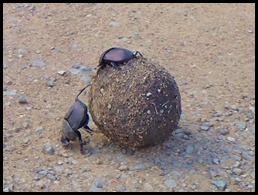 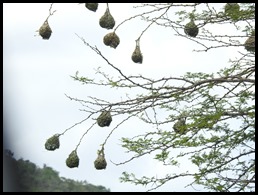 Kimi spotted a very colourful chap and took the best picture she could given
the angle and lack of help from her subject. We were all very pleased to see our
first dung beetle (own blog) with wife along for the
ride and then a tree hanging with weaver bird
nests.
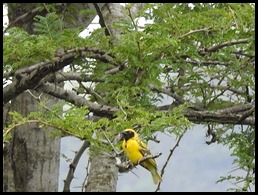  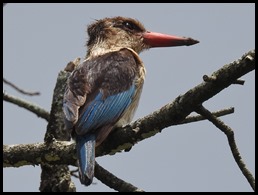 We watched the antics of the busy
weaver birds (own blog) when we saw a black-throated
barbet, our first nyala deer, a yellow jobby and then
a cracker from Kimi – a kingfisher. Dragonflies of all sizes in huge numbers all
around.
 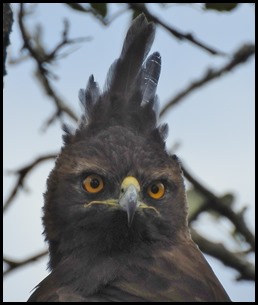 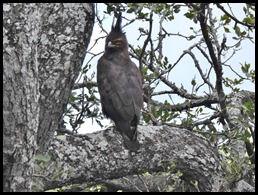 Then I scored a hit, the silhouette of a big boy. Bear crept the car closer and we ended up with a good look at a long-crested eagle. Bodyweight around one kilo, standing at 56 cms with yellow eyes and white trousers. This chap is welcomed by farmers as ninety per cent of the long-crested eagles’ diet is made up of rats, the other bit of frogs, small reptiles and insects. They hunt in the mornings and evenings and rest in the shade during the day on their relatively small home range of about thirty-five square kilometres. Quite happy to make use of another raptors nest, this monogamous bird lays two eggs at different intervals that may hatch up to two weeks apart. The husband takes charge of feeding his wife as she takes to the full-time task through incubating the eggs. The chicks fledge at fifty-plus days but need parental support for another two to three months.
Eyes open,
sinister when closed but ever-watchful for a snack.
 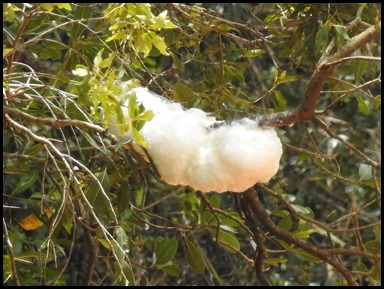 We stopped at a waterhole but all we saw was some, well, what looked like white candy floss on a couple of branches (we
would find out later from our digs owner that it is nothing more than a fungus). Can’t be harmful as no one seems to fazed by
it.
 We had a river to
our right for a time.
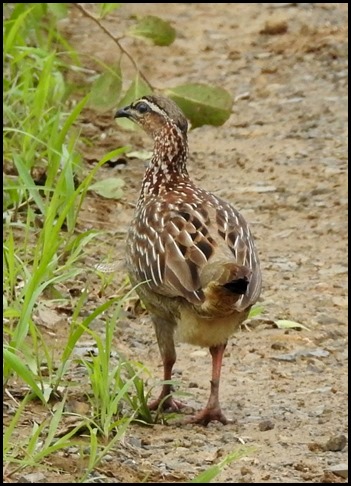 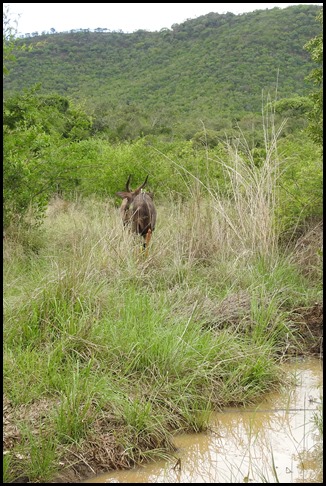 The first of our many creatures
bimbling beside the road (or track) was a little
francolin and then we saw our first male
nyala.
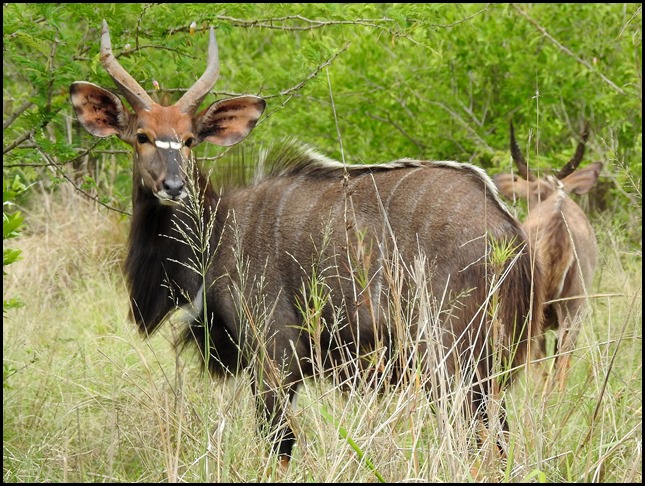 Fortunately, he had a friend who was happy to pose.
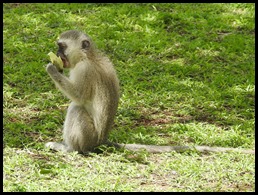 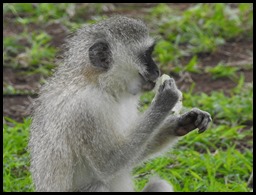 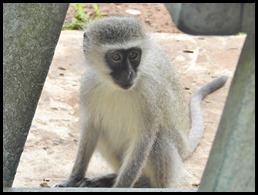 We stopped to stretch our legs at a
picnic site where we watched a troop of monkeys being
cute and mischievous.
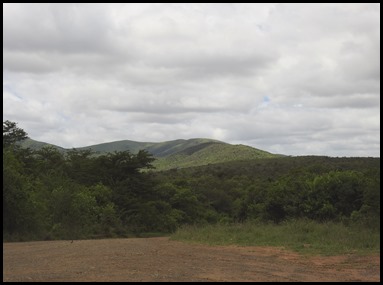 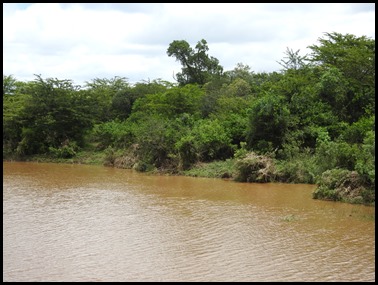 We followed the
track to more water.
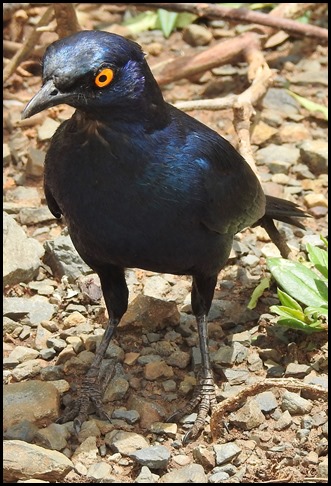 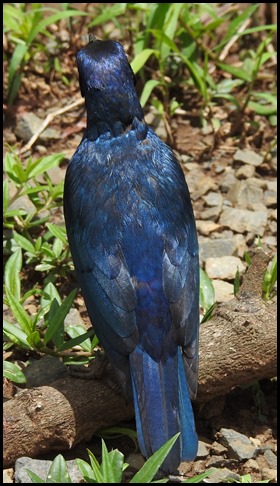 A very handsome Cape glossy starling stood to pose and then turned his back
for us to see his stunning blue coat.
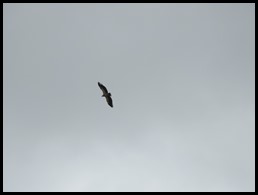 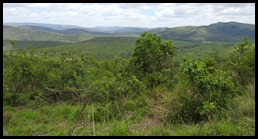 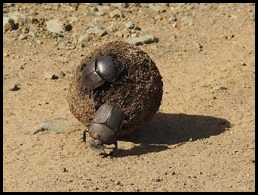 An osprey
soared overhead as we began to slowly go uphill. Of
course we stopped for another dung beetle or
two.
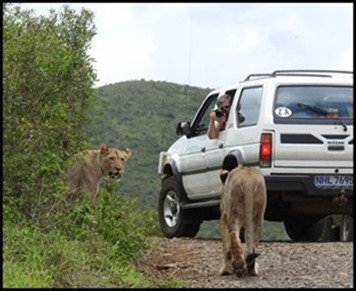 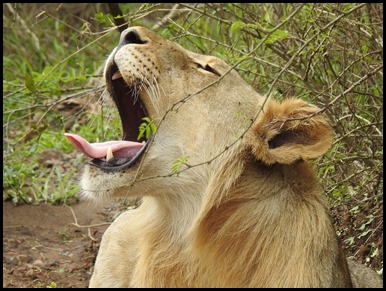 We were just heading up
an incline when we saw several stationery cars. Mincing along were two lionesses, another out of shot as the young male
bimbled between the cars to flop down a few feet away under a bush. Trevor took
this gorgeous picture of the chap at full yawn. Wow.
We spent fifteen minutes with the small group (own blog) before driving away
very happily.
 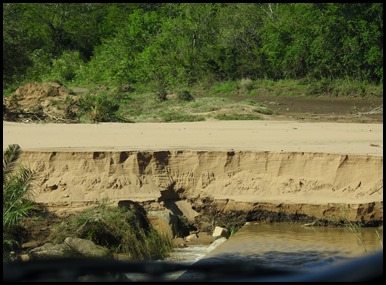 Very much off
tarmac, Trevor headed us to a lookout but even in a 4x4 we would not have
been able to cross as the bridge was missing.
Richards Bay to here have had colossal amounts or rain and storms, even a
tornado or two that have caused quite a bit of damage and road
floods.
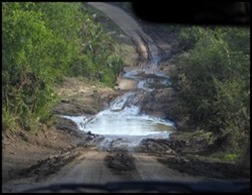 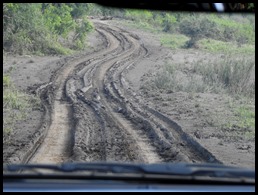 Bear took the puddle in his stride on a parallel track, we waited to make
sure another car came through OK and then took on
a ‘sticky’ bit.
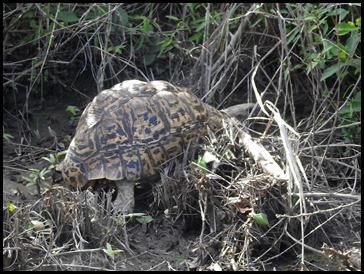 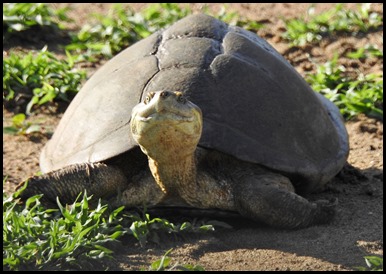 Now I clearly did not get the memo.
Tortoises....... really. We ended up seeing three
different sorts. We also spotted sparrows, thrushes, swifts, starlings, finches,
Indian Mynah birds (they are getting everywhere), a mongoose, a barbet, pigeons,
a quail, two Steppe buzzards and a pretty Steenbok.
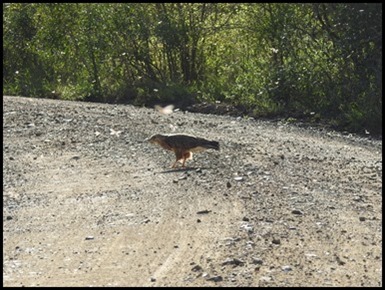 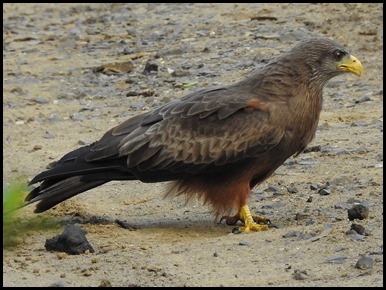 This chap was on
the track making the most of the myriad of insects. Happy to pose too.
  Loved watching him march purposefully until he settled in
a tree to let several cars go by........
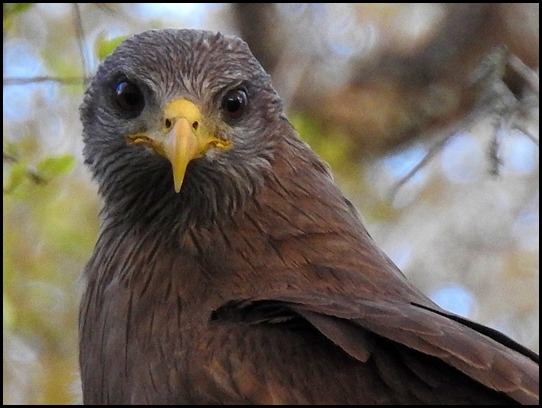 ..........to stare
at us.
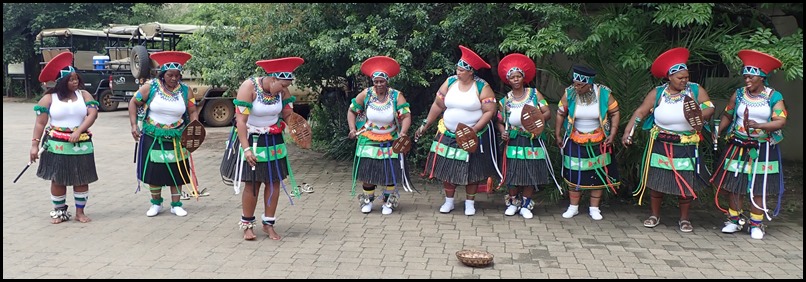 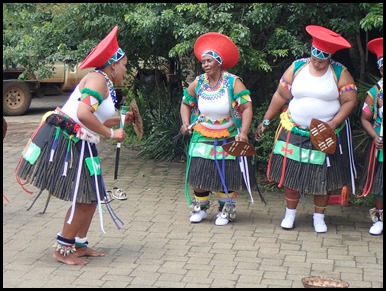 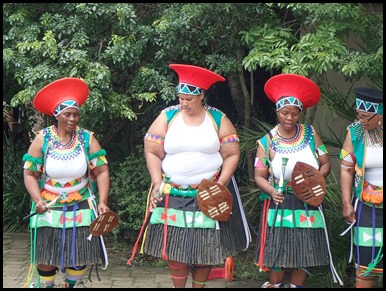 Time for lunch. We made our way to
Hilltop where a local dance group put on a lovely
show.
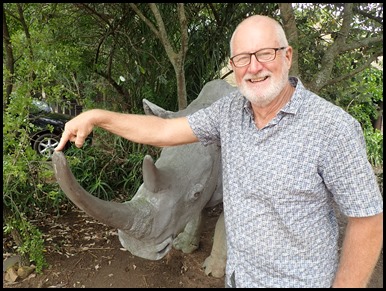 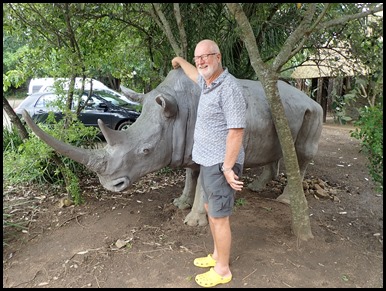 Of course
he did with a garden ornament.........
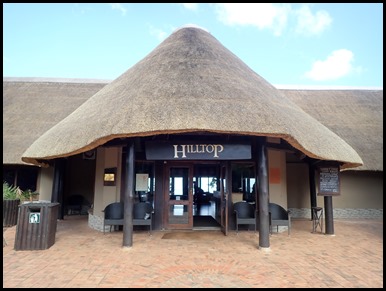 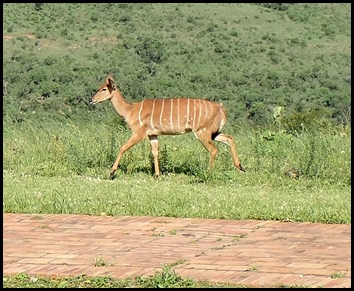 The
Hilltop. Settled inside (there were a fair few monkeys as well as no
empty tables), once a monkey had been shooed away from helping himself to
packets of sugar, all was peaceful in our corner. We placed our order and
reviewed our busy and productive morning as we watched nyala bimble about. Two of the Big 5 ticked
off........
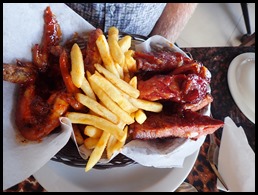 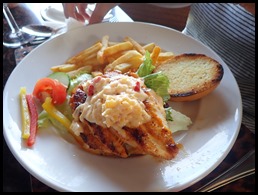 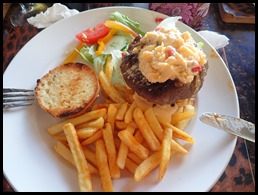 Bear enjoyed wings and ribs, Kimi the chicken
whilst Trevor and I went for the cheeseburger.
Very naughtily we left room for the lightest of cheesecakes with ice
cream.......A quick look around the shop and we were ready for
more.
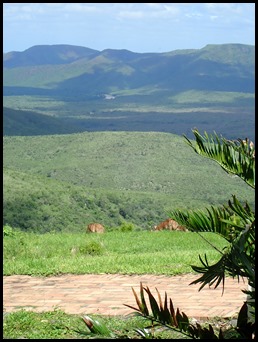 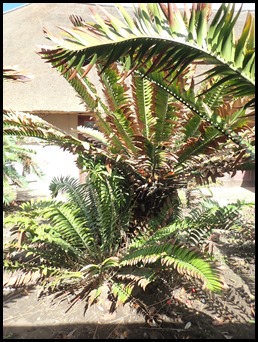 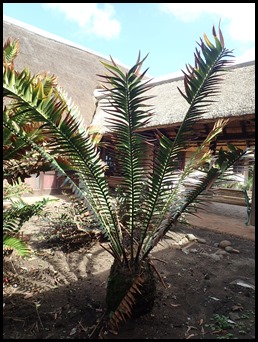 One final look at the nyala and scenery and as it was
toilet break, I could take in the endangered cycad
collection at the front of the building. The information board
read: These Natal cycads (Encephalartus natalensis) are relatives of
pine trees and other cone-bearing plants. They dominated the landscape in the
Mesocoic era about 200 million years ago. Individual plants often live a long
time. The oldest in South Africa is about a thousand years old and was declared
a scientific monument in 1951. Cycads are fitted with microchips too allow for
easy identification and tracking. This is necessary because of the trade value
of cycads for display as garden specimens. The illegal trade of cycads has
resulted in many species becoming critically endangered and even locally extinct
in some areas. It is a criminal offence to transport a cycad without a permit
from Conservation Authorities.
Cycads are an important food
source in nature, It is thought that they were a major part of the diet of
herbivorous (plant eating) dinosaurs and today the fleshy seeds are eaten by
hornbills, monkeys, baboons and cattle and the gum is eaten by birds and
children. The leopard magpie moth
(Zerenopsis leopardina) lays its eggs only on cycads and its caterpillars can
strip a plant of all its young leaves.
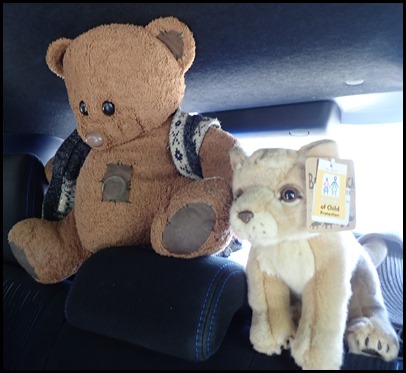 Back in the car Beds was introduced to Nala (Kimi’s new baby), he was
incredibly protective from the start.
CONTINUED |
